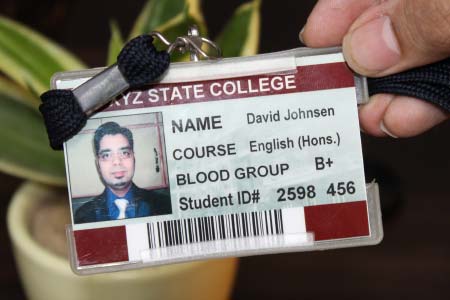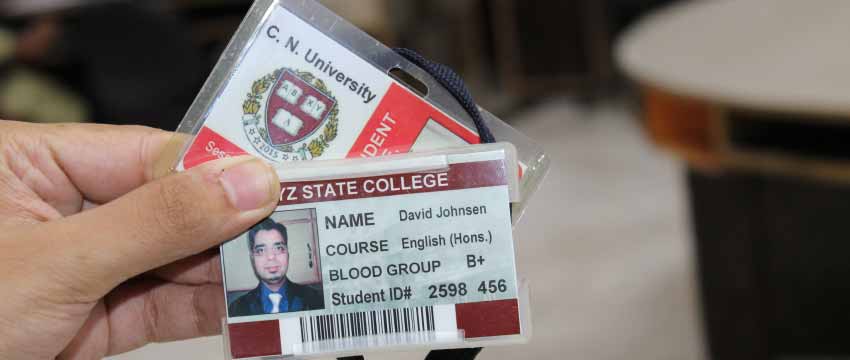Student ID Badges Maker: Color Selection, Design Practices, and Printing
By: Techsavvy
| 25/07/2023
Color Selection is Important When Creating A Student ID Badges
Color selection plays a significant role when creating student ID badges using a student ID badges maker. The choice of colors can have a substantial impact on the overall design, readability, branding, and visual appeal of the ID badges. Here are some detailed reasons highlighting the importance of color selection:

-
Branding and Identification: Colors can be used to represent and reinforce the branding of an educational institution. By incorporating the school's official colors into the ID badges, you create a cohesive visual identity that aligns with the institution's image. This consistency helps students, staff, and visitors quickly identify individuals associated with the school.
-
Differentiation and Hierarchy: Color selection can be used to differentiate between various groups or levels within an educational institution. For example, different colors can be assigned to students of different grades or departments. This helps distinguish between different groups and creates a visual hierarchy, making it easier to identify individuals belonging to specific categories.
-
Visual Appeal and Engagement: Well-chosen colors can enhance the visual appeal of ID badges and make them more engaging. Vibrant and attractive colors can catch attention, making the badges more memorable and encouraging people to wear them consistently. This is particularly important for student ID badges, as visually appealing designs are more likely to be embraced and worn proudly by students.
-
Readability and Legibility: The colors used for text and background play a crucial role in ensuring readability and legibility. High contrast between the text and background color is essential for easy reading, especially for small fonts or when the badges are viewed from a distance. Avoiding color combinations with poor contrast, such as light text on a light background, ensures that the information on the ID badges can be quickly and accurately read.
-
Safety and Security: In some cases, specific colors may be used to indicate different security clearances or access levels. For example, certain colors may be assigned to denote different zones or areas within a school that have restricted access. This helps security personnel quickly identify authorized individuals and maintain a secure environment.
-
Cultural Considerations: It's important to consider cultural associations and perceptions related to colors. Different colors can carry various meanings in different cultures, so it's essential to choose colors that are culturally appropriate and don't inadvertently convey unintended messages or symbolism.
In summary, color selection in student ID badge design is crucial for branding, identification, differentiation, visual appeal, readability, safety, and cultural considerations. By carefully choosing colors that align with the institution's brand and effectively communicate information, you can create visually appealing and functional ID badges that serve their intended purpose effectively.
There are Best Practices for Designing Effective and Secure Student ID Badges
Designing effective and secure student ID badges using a student ID badge maker involves considering various factors to ensure the badges serve their intended purposes. Here are some best practices to follow:
-
⇒Include Essential
Information:
Include the student's full name and a clear, recent photograph for easy identification.
Display the name of the educational institution prominently, along with its logo or crest, to establish the badge's legitimacy.
Add a unique identification number or barcode to enable quick and accurate scanning or tracking.
-
⇒Use High-Quality Images:
Ensure that the student's photograph is of high resolution and properly lit for accurate identification.
Use a consistent background for all photographs to maintain a professional look.
Avoid images that are too small or blurry, as they may hinder identification or compromise security.
-
⇒Incorporate Security
Features:
Consider using security features like holographic overlays, UV ink, or microprinting to deter counterfeiting or tampering attempts.
Employ overt security measures, such as custom watermarks, that are easily recognizable to enhance authenticity.
-
⇒Prioritize Durability:
Use high-quality materials and lamination techniques to ensure the ID badges are durable and resistant to wear and tear.
Consider protective measures like holographic overlays or tamper-evident seals to prevent unauthorized modifications.
-
⇒Maintain Privacy:
Limit the personal information displayed on the badge to only essential details, such as the student's name and photograph.
Avoid including sensitive information like addresses or contact numbers to protect privacy and reduce the risk of identity theft.
-
⇒Follow Design Guidelines:
Adhere to the design guidelines and specifications provided by the badge maker manufacturer for optimal printing and compatibility.
Ensure that the layout, font size, and colors used on the badge are clear, legible, and consistent for easy readability.
-
⇒Implement Access Control:
Include an access control mechanism, such as a barcode or RFID chip, that can be scanned or swiped for entry into specific areas or activities.
Ensure that access privileges are clearly indicated on the badge, allowing authorized personnel to quickly identify authorized areas or resources.
-
⇒Regularly Audit and
Update:
Implement a system to regularly review and update the ID badges as needed. This can include verifying the accuracy of student information, removing expired badges, or updating access privileges.
Conduct periodic audits to ensure that ID badges are being used appropriately and that security measures are effective.
By following these best practices, you can design student ID badges that are effective in identifying individuals, enhancing security, and maintaining the integrity of your educational institution's identification system.
Print Student ID Badges with Barcodes or QR Codes
Yes, it is possible to print student ID badges with barcodes or QR codes using a student ID badge maker. These technologies are commonly used in educational institutions to streamline student identification processes and enhance security measures. Here's a detailed explanation of how it works:

-
Placement on ID Badge: After generating the barcodes or QR codes, the badge maker software allows you to position them on the ID badge design. You can determine the size, location, and orientation of the barcode or QR code to ensure optimal readability.
-
Printing the ID Badges: Once the badge design is finalized, including the barcodes or QR codes, you can proceed to print the ID badges. Most ID badge makers support various printing options, such as direct printing on PVC cards or printing on adhesive labels that can be affixed to pre-printed badge templates.
-
ID Badge Encoding: If your student ID badges require additional functionality, such as access control or attendance tracking, you can encode the barcode or QR code with specific information. For example, the barcode could contain a unique student ID number that grants access to specific areas or tracks attendance when scanned.
-
Scanning and Verification: Once the ID badges are printed and distributed to students, the barcodes or QR codes can be scanned using appropriate scanning devices. These devices can be handheld barcode scanners or smartphone applications capable of reading QR codes. Scanning the codes retrieves the encoded information, allowing for quick and accurate identification and verification of students.
-
QR Code Generation: Similarly, if you choose to use QR codes, the software generates a unique QR code for each student. QR codes are two-dimensional barcodes that can store a larger amount of data compared to traditional barcodes. They can be scanned by smartphones or dedicated QR code scanners.
To create student ID badges with barcodes or QR codes, you'll need a badge maker software. This software allows you to design and customize the appearance of the ID badge, including the layout, colors, text, and images. It also enables you to generate and insert barcodes or QR codes onto the badge.
The badge maker software typically integrates with a student information system (SIS) or a database that contains student details such as names, ID numbers, and other relevant information. This integration allows for automatic data population on the ID badges, eliminating the need to manually input student information.
Once the badge design and data integration are in place, the software generates a unique barcode for each student. Barcodes are machine-readable symbols that contain encoded information. They can be in various formats such as Code 39, Code 128, or others, depending on the requirements and compatibility of your ID badge system.
By incorporating barcodes or QR codes into student ID badges, educational institutions can streamline administrative processes, enhance security measures, and enable efficient data tracking and analysis. These technologies provide a versatile and effective solution for student identification and management.